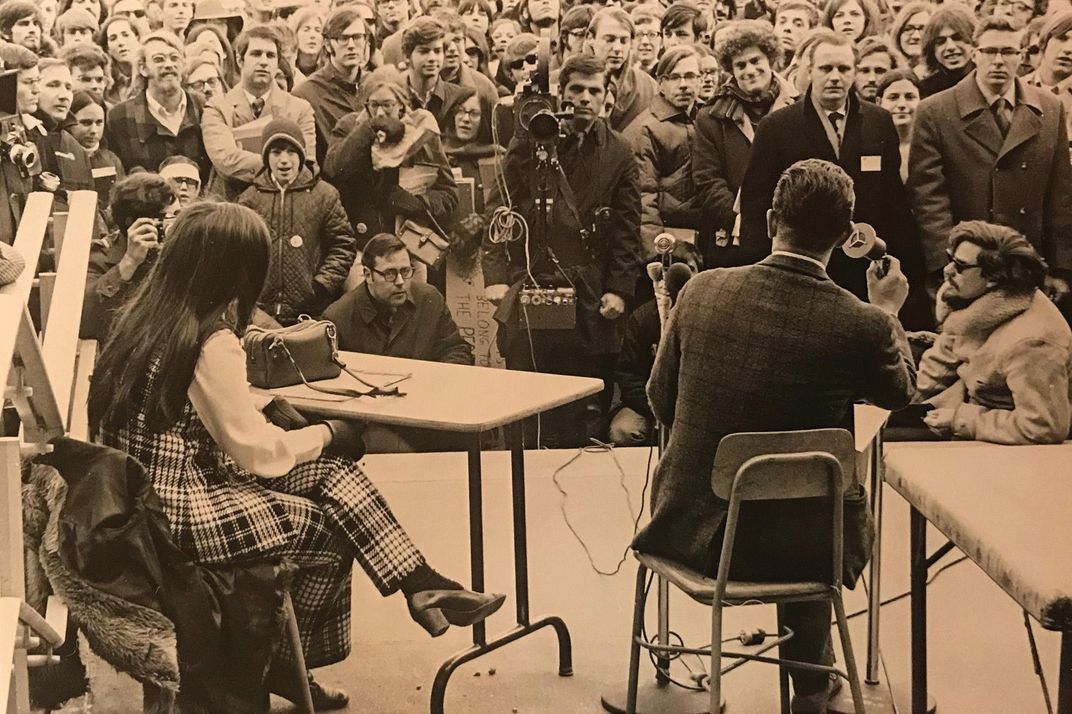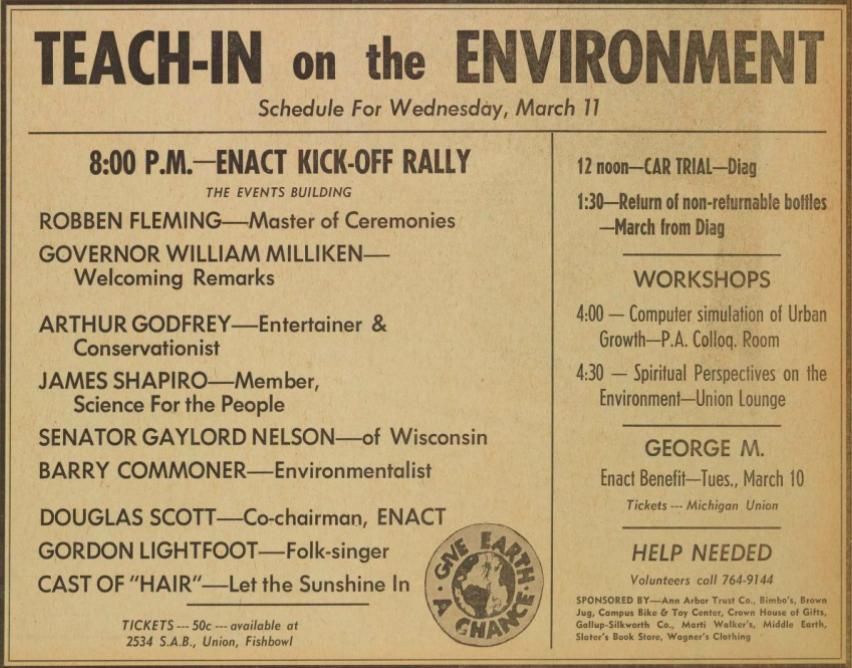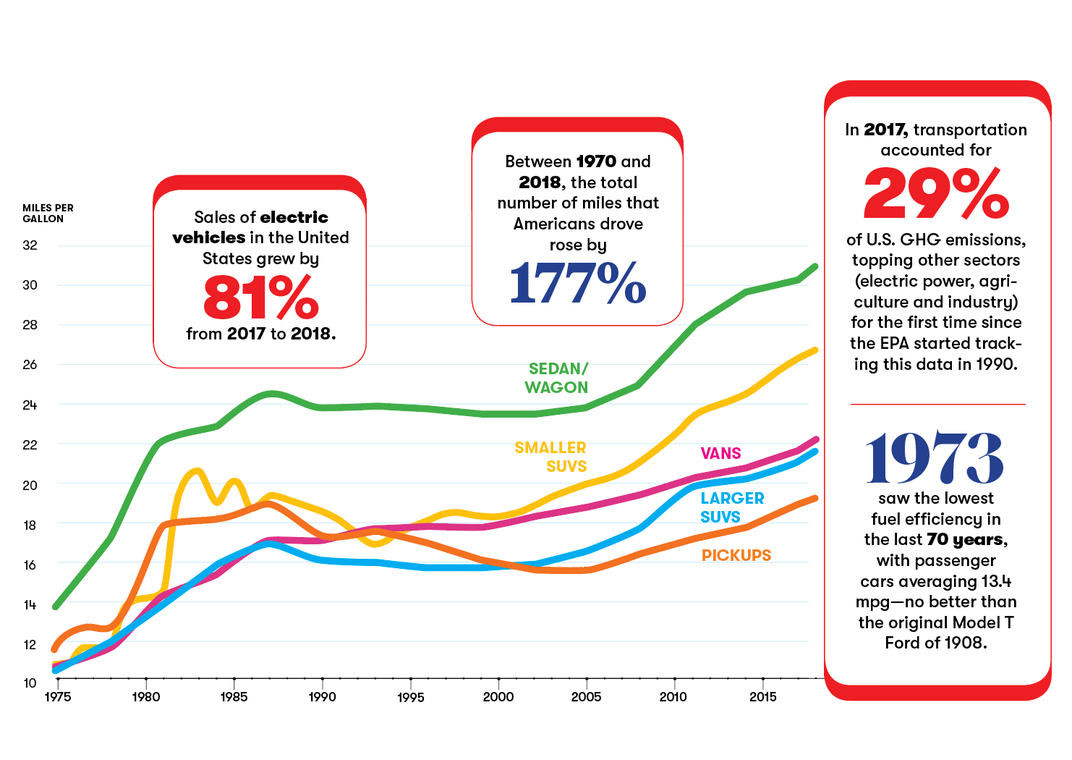When Michigan Students Put the Car on Trial
In a famous 1970 teach-in demonstration, prosecutors hammered away at the nation’s most powerful defendant
/https://tf-cmsv2-smithsonianmag-media.s3.amazonaws.com/filer/6f/cf/6fcf4ca8-7a60-475c-8019-286d0cce6c0b/untitled-1.jpg)
Gordon Lightfoot and the Broadway cast of Hair performed. Barry Commoner and Ralph Nader spoke. But the most bizarre event at the University of Michigan’s teach-in the month before the first Earth Day was a mock legal trial for a 1959 Ford sedan.
About 1,000 people gathered at high noon on March 11, 1970, on the grassy quad at the center of the Ann Arbor campus to watch the blue-and-white clunker face charges of “murder of the American public, crossing state lines to pollute, inciting traffic jams, creating physical and psychological dependence, and discriminating against the poor.” This last charge reflected newly urgent concerns about highways, which tended to be built in lower-income neighborhoods, and resulted in polluting and sometimes even bulldozing those communities.
The sedan had a lot going for it—powerful witnesses for the defense; a distracted judge, who spent the mock trial reading an issue of Auto Racing (such ruling-class complacency amid ecological crisis!); and a society increasingly built around cars as the primary form of transport.
“Rob Rockyfeller,” witness for the defense, testified that his (fictional) foundation had found that auto exhaust was only half as toxic as aspirin. His appearance lampooned the various foundations that supported business-friendly policy in the name of general prosperity. Another witness attested to the importance of cars to the American economy. But no witness evoked the country’s car mania more vividly than “Dr. Sigmund Ford,” who sat stiffly on the stand with his head tilted slightly back, looking down his nose at the crowd below him.
“The automobile is essential to the maintenance of the American’s psyche,” Ford shouted, urging the court to consider the emotional security a car gives to the American man. “You can’t take it away from him! How else could he know his power and virility? How can we show our neighbors we’re stronger and more powerful than they are without a Lincoln Continental?”
“But what would actually happen to [Americans] if you took away cars?” asked the prosecutor, wearing a plaid suit and, of all things, leather driving gloves.
“But you see, cars are very important,” Ford began, dodging the question. “They serve a function—”
“What would be the effect on people?” the prosecutor interjected. Ford couldn’t provide a satisfactory answer. “You just can’t take away their cars,” he shouted. “You can’t take away my car!”

The judge, stirred briefly from his magazine, found Dr. Ford a compelling witness and ruled the sedan innocent before accusing a dozen activists of “conspiring” against the automobile. A handful of activists then unceremoniously debenched the judge and turned the trial over to the assembled crowd, who delivered a guilty verdict. The car was sentenced to death. Bystanders smashed it to pieces with sledgehammers.
The automobile was a common target for such stunts at environmental teach-ins that year. At a rally in February at San José State University, student-activists bought and then buried a new car; at Indiana’s DePauw University on Earth Day, one student arrived on campus on horseback with a sign that read “Ban the automobile.”
But the mock trial in Michigan was a bold move in a state whose economy was still very much tied to the auto industry. In 1970, forty-two percent of Americans employed in the manufacture of automobiles and equipment called Michigan home. Ralph Nader, author of the landmark 1965 book Unsafe at Any Speed: The Designed-In Dangers of the American Automobile, which would help force the auto industry to transform its safety standards, told audiences in Ann Arbor that corporations, not consumers, were responsible for the pollution from automobiles. Significantly, the rally wasn’t attended only by college kids, so often accused of being unfamiliar with the real world. Industry leaders attended, and Walter Reuther, president of the United Auto Workers, was on hand to demand environmental reforms from car companies. The UAW donated $2,000 to the national Earth Day teach-in.
“If you ask me, ‘Can we solve [ecological crises] within the framework of business-as-usual?’ My answer is no,” Reuther said in an interview at the teach-in. “We’ve got to create new instruments, new institutions; we’ve got to develop new approaches and new concepts to deal with these new problems.”
Reuther was adamant that cleaning up cars didn’t have to cost autoworkers jobs. “Because industry has for so long polluted the environment of the plants in which we work and has now created an environmental crisis of catastrophic proportions in the communities in which we live, the UAW will insist on discussing the implications of this crisis at the bargaining table,” he said at the UAW’s annual convention in Atlantic City in April of that year.
Indeed, pollution had finally become a national concern: In 1970, levels of common air pollutants were about 73 percent higher than they are today, and the automobile was the main culprit. “Nobody was talking about climate change at that time,” says Doug Scott, then a graduate student in the School of Natural Resources and co-chair of the group that organized the university’s teach-in. “But there was just a general perception that the freeways packed with one driver per car pouring out leaded gasoline was not a good thing.”

Nobody expected the trial stunt alone to change policy. But the guerrilla theater was a way for the young generation to make a memorable point. “We tended not to reject ideas,” Scott says. “Someone, and I couldn’t tell you who, decided that an awfully good way to get this going would be to take sledgehammers to a gas guzzler.”
The teach-in helped shape the lives of some of the student activists. Doug Scott went on to lobby Congress on behalf of nonprofit advocacy organizations such as the Wilderness Society and the Sierra Club; one of his most notable achievements, he says, was helping pass the Alaska National Interest Lands Conservation Act of 1980, which more than doubled the size of America’s national park system.
And a few months after the teach-in, the UAW joined environmental groups including Environmental Action and the Sierra Club in signing a resolution calling on Congress to make air pollution standards strict enough to force auto companies to phase out the internal combustion engine. Instead, carmakers developed and embraced the catalytic converter, which helped drastically reduce air pollution and allowed the internal combustion engine to live on.
As air pollution from automobiles dropped, their footprint on the ground kept growing. In the decades that followed, disputes about proposed highways that would cut through city neighborhoods continued across the country. George Coling, a member of the teach-in’s steering committee while a graduate student at Michigan’s School of Public Health, pursued a long career in ecological activism, and saw the toll of these freeway fights up close. “There were massive intrusions of interstates into urban neighborhoods, which meant displacement of whole areas, razing of homes and businesses,” says Coling.
To Coling, the car’s show trial and violent execution were about more than just pollution: They symbolized the need to move beyond a car-based transportation system toward one that offered better mass transit, which could be more environmentally friendly and cost users less.
Still, looking back after a long career in environmental justice, he acknowledges that destroying a car was not a wholly righteous thing to do. “The act of smashing a car is quite elitist,” Coling says, because it fails to consider “the very real need that people have for transportation.” Americans may not be as psychologically dependent on cars as Dr. Ford claimed, but they still need them to get around. Even the unnamed owner of the executed car admitted at the demonstration, over the arrhythmic clang of sledgehammers on metal, that he had donated the vehicle after purchasing a new car.
The Road More Traveled
Vehicles today are greener, thanks to government standards and new technology. So why are climate-warming emissions piling up?
